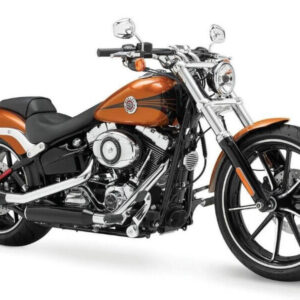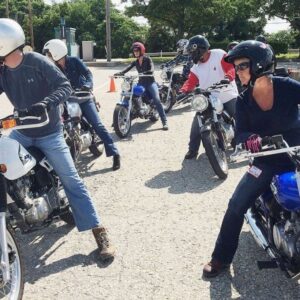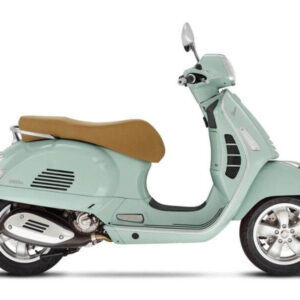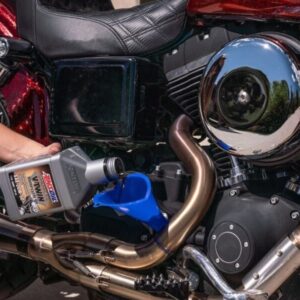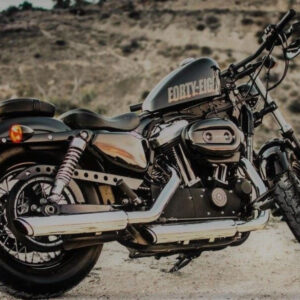When were motorcycles invented? Like many inventions, the motorcycle evolved in gradual stages, without a single inventor who can lay sole claim to being the inventor. Early versions of the motorcycle were introduced by numerous inventors, mostly in Europe, in the 19th century.
When were motorcycles invented?
The first motorbike as we would understand it today appeared in 1885 in Germany.

Built by Gottlieb Daimler, and Wilhelm Maybach, both later to become famous for their car brands, the Daimler Reitwagen was a very basic experimental prototype rather than a full-fledged useful transport solution. It did use a petrol-powered engine though.
The first production motorcycle was the Hildebrand and Wolfmüller, produced between 1894 and 1897.
Why was the motorbike invented?
The motorbike came about as a simple way to produce motorised transport cheaper than a four-wheeled car.
The basic technology behind early models – the pedal-powered bicycle – was an obvious foundation to start with, and early pioneers quickly worked out how to mount engines in the frame to replace human-powered pedal drive.
This allowed higher speeds and longer range at a lower cost than a motor car – which meant many more people were able to afford to buy them.
A brief history of the Motorcycle
Perhaps surprisingly, motorbikes were invented at almost exactly the same time as cars. The Daimler Reitwagen, built by Gottlieb Daimler, first appeared in 1885, the same year as Karl Benz built his Patent Motorwagen – the first petrol-powered motor car.
Steam-Powered Bicycles
American Sylvester Howard Roper (1823-1896) invented a two-cylinder, steam-powered velocipede in 1867. A velocipede is an early form of a bicycle in which the pedals are attached to the front wheel.
Roper’s invention can be considered the first motorcycle if you allow your definition of a motorcycle to include a coal-fired steam engine. Roper, who also invented the steam-engine car, was killed in 1896 while riding his steam velocipede.
Around the same time that Roper introduced his steam-powered velocipede, Frenchman Ernest Michaux attached a steam engine to a velocipede invented by his father, blacksmith Pierre Michaux. His version was fired by alcohol and twin belt drives that powered the front wheel.
A few years later, in 1881, an inventor named Lucius Copeland of Phoenix, Arizona developed a smaller steam boiler that could drive the rear wheel of a bicycle at the amazing speed of 12 mph. In 1887, Copeland formed a manufacturing company to produce the first so-called “Moto-Cycle,” though it was actually a three-wheeled contraption.
The first Gas-Engined motorcycle
Over the next 10 years, dozens of different designs for self-propelled bicycles appeared, but it’s widely acknowledged that the first to use a gasoline-powered internal combustion engine was the creation of German Gottlieb Daimler and his partner Wilhelm Maybach, who developed the Petroleum Reitwagon in 1885.
This marked the moment in history when the dual development of a viable gas-powered engine and the modern bicycle collided.

Gottlieb Daimler used a new engine invented by engineer Nicolaus Otto. Otto had invented the first “Four-Stroke Internal-Combustion Engine” in 1876, dubbing it the “Otto Cycle Engine” As soon as he completed his engine, Daimler (a former Otto employee) built it into a motorcycle.
Oddly, Daimler’s Reitwagon did not have a maneuverable front wheel, but instead relied on a pair of outrigger wheels, similar to training wheels, to keep the bike upright during turns.
Daimler was a prodigious innovator and went on to experiment with gasoline motors for boats, and he also became a pioneer in the commercial car manufacturing arena. The company bearing his name eventually became Daimler Benz—the company that evolved in the corporation we now know as Mercedes-Benz.
Continued Development
From the late 1880s onward, dozens of additional companies sprang up to produce self-propelled “bicycles,” first in Germany and Britain but quickly spreading to the U.S.
In 1894, the German company, Hildebrand & Wolfmüller, became the first to establish a production line factory to manufacture the vehicles, which now for the first time were called “motorcycles.” In the U.S., the first production motorcycle was built by the factory of Charles Metz, in Waltham, Massachusetts.
The Harley Davidson Motorcycle
No discussion of the history of motorcycles can end without some mention of the most famous U.S. manufacturer, Harley Davidson.
Many of the 19th-century inventors who worked on early motorcycles often moved on to other inventions. Daimler and Roper, for example, both went on to develop automobiles and other vehicles.
However, some inventors, including William Harley and the Davidsons brothers, continued to exclusively develop motorcycles. Among their business competitors were other new start-up companies, such as Excelsior, Indian, Pierce, Merkel, Schickel, and Thor.
In 1903, William Harley and his friends Arthur and Walter Davidson launched the Harley-Davidson Motor Company. The bike had a quality engine, so it could prove itself in races, even though the company initially planned to manufacture and market it as a transport vehicle. Merchant C. H. Lange sold the first officially distributed Harley-Davidson in Chicago.
Types of motorbike explained
Today, there’s a massive range of motorbikes available, to suit a wide variety of needs.
Starting at the most basic level, small-capacity scooters provide cheap simple transport for hundreds of millions of people worldwide, giving mobility to communities with few other options.
The scooter design – a step-through frame design, protective bodywork and automatic engine – appears elsewhere too though, in large-capacity high-performance form for well-heeled city commuters in Europe.

At the other end of the scale is the superbike – a very high performance sports machine, with more than 200bhp available from a high tech multi-cylinder engine, race-spec tyres, brakes and suspension, and aerodynamic fairings protecting the rider from near-200mph wind blast.
Recent years have seen an upsurge in popularity for naked machines – standard motorcycle designs, with no plastic bodywork, and the engine and chassis parts all laid out on show.
These have a more upright relaxed riding position, and are less suited to high speed riding than a faired machine.
Off-road riding has always had a strong appeal, and dirt bikes are as popular as they’ve ever been. That includes small-bore lightweight designs, aimed at riding through really tricky terrain – sand, mud, hills and fields – as well as much larger ‘adventure’ type bikes.
Adventure machines have some off-road potential, with plenty of ground clearance, knobbly tyres, high seats and torquey engines.
But they’re also big and fast enough to carry two people and luggage for hundreds of miles a day on motorways – so owners can go on long-distance ‘adventures’ with ease.
Biking has always had an element of showing off – and there are a few sectors of the market which are perfect for this. First is probably the custom/cruiser variant – Harley-Davidson being the archetypical marque here.
Long, low-slung, unfaired machines, with large V-twin engines, lashings of chrome plate and high-end metal flake paintjobs catch the eye, and are perfect for living the West Coast USA lifestyle – even if you’re riding through a drizzly Walsall.
The other showy option, and very popular of late, is the retro ‘hipster’ model.
This can be factory built – like the Triumph Bonneville Bobber, the Husqvarna Vitpilen, or the BMW RnineT – or they can be bespoke customs, either home-made or specialist-build, based on Honda CB or BMW Boxers from the 1970s and 80s.
There’s often a mild steam-punk feel, and a harking back to the 1950s, in dress as well as bike choice.
Brown leather seats abound, and there should be a minimalist feel, but in general, anything goes – so long as it’s been well-executed and had a lot of design effort put in.
FAQs
When did motorcycles become popular?
1940’s: World War II ended, and motorcycle sales in America and Europe skyrocketed. This was due to the large number of veterans returning home after having ridden these vehicles during the War. It turns out, these men were anxious to own their own bike. This was when the ‘cruiser’ design became popular as well.
Were motorcycles used in war?
Military motorcycles made their first appearance in an era in which everything motorized got militarized. First used by Pancho Villa during the Mexican Revolution, it was for the First World War that the military motorcycle made its real debut.
What is the oldest motorcycle sold?
This 1894 Hildebrand & Wolfmüller is listed as the world’s oldest production motorcycle. Media sourced from Bonhams. “Sold for €195,500 inc. premium.”
Above is information about When were motorcycles invented? that we have compiled. Hopefully, through the above content, you have a more detailed understanding of A brief history of the motorcycle. Thank you for reading our post.

